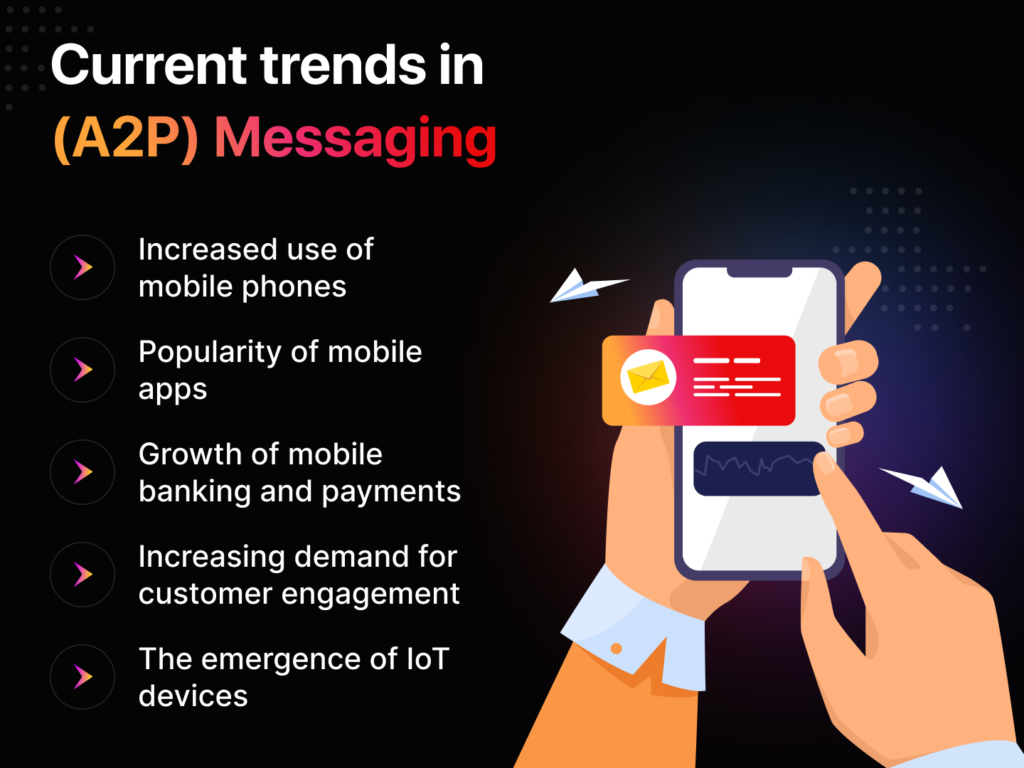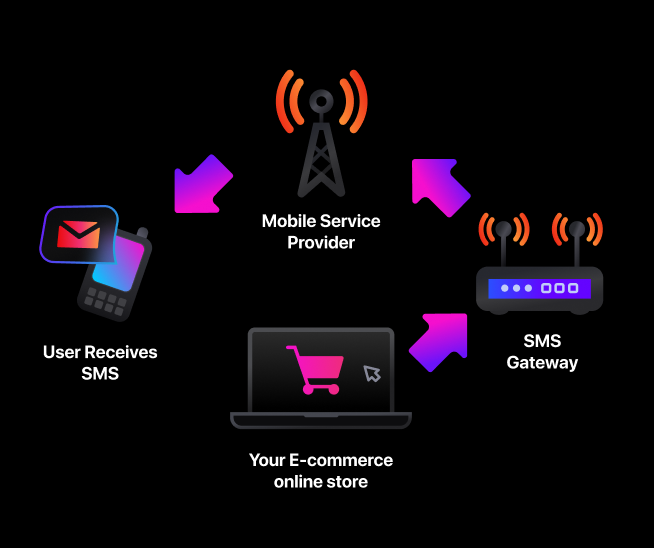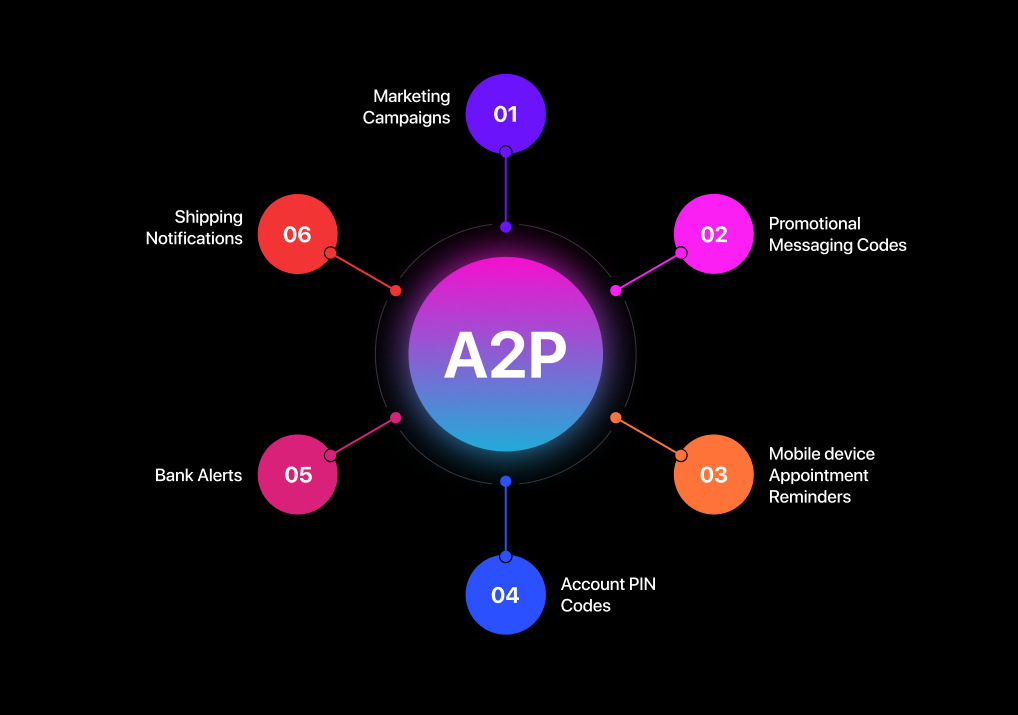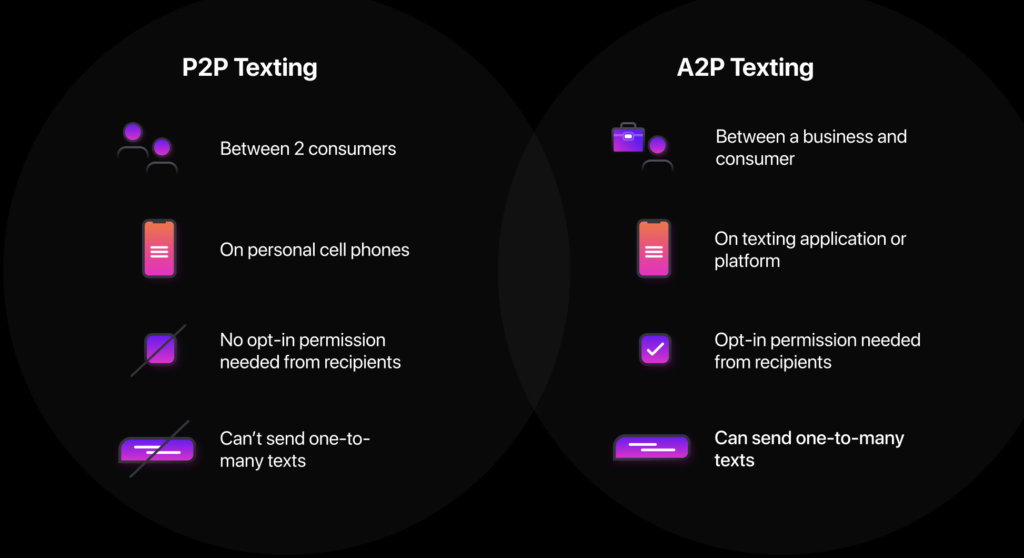What is A2P Messaging: Everything You Need to Know [2023]
Did you know that the average person who owns a smartphone spends more than 7 hours daily using it?

For business owners, smartphones provide an efficient and cost-effective way to communicate with customers, and A2P messaging is one of the most powerful marketing methods available.
Keep reading to learn more.
Application-to-Person (A2P) Messaging: How Does it Work
A2P Messaging Service, or enterprise or professional SMS, refers to Application to Person messaging.

In A2P messaging, messages are sent from an application-based software to a recipient.
It is typically one-way communication, meaning the recipient doesn’t always need to respond.
Customers opt-in to receive text message notifications, allowing them to interact with businesses through their mobile network connection.
A2P is commonly used for marketing campaigns, promotional messaging codes, mobile device appointment reminders, account PIN codes, bank alerts, shipping notifications, and other types of short codes and long codes.

Various industries, including retail, banking, telecom, healthcare, and travel, have adopted A2P technology.
The A2P messaging intelligence offers advanced features that allow you to customize the text messages, control who receives them, and use reliable routes to deliver the messages.
Companies can send smart SMS messages to their entire customer base worldwide, ensuring reliability and timeliness.
It also brings improvements in service delivery, fraud alerts, and reporting capabilities.
If utilized wisely and for appropriate purposes, A2P messaging can provide impressive outcomes.
As we mentioned in the beginning, A2P messaging is a cost-effective way to boost consumer engagement, as approximately 98% of text messages are opened by the receiver.
On the other hand, P2A messaging is the opposite of A2P messaging, where customers initiate SMS conversations with a software application.
An example is when mobile users vote for their favorite contestant on a talent show competition.
Current Trends in Application-to-Person (A2P) Messaging
- Increased use of mobile phones
The widespread use of mobile phones worldwide has increased the need for A2P SMS messaging services. These services enable businesses to reach a diverse customer base through text messaging.
- Popularity of mobile apps
The growing popularity of mobile apps has further fueled the demand for A2P SMS services.
Many apps rely on A2P SMS to send notifications to users, prompting businesses to seek hassle-free ways to engage with their app users.
- Growth of mobile banking and payments
The expansion of mobile banking and payment services has also contributed to the growth of the A2P SMS market.
SMS is commonly used to deliver secure authentication codes and other notifications related to financial transactions.
- Increasing demand for customer engagement
In response to companies’ increasing desire to engage with their customers and foster stronger relationships, there has been a higher demand for A2P SMS services due to their simplicity and cohesiveness.
- The emergence of IoT devices
The emergence of IoT devices, such as smart meters and connected cars, has created a need for SMS-based data communication.
This presents new opportunities for A2P SMS providers to cater to the communication needs of IoT devices.
- Growth in Diverse Product Types
The A2P messaging market offers a variety of product types, including OTT A2P and A2P SMS, with the latter holding the largest market share in 2022.
Other product types are also available to meet specific needs and preferences.
- Expansive Growth of the A2P Market
Research indicates that the A2P Messaging market is expected to witness positive growth in the next five years, with the market size projected to increase from its estimated value in 2022 to a higher value in 2028, with a compound annual growth rate (CAGR) during the forecast period.
A2P vs P2P: Which one is better for me?
A2P (Application-to-Person) and P2P (Person-to-Person) messaging are not identical, although they share some similar values.

Although the text messages you receive may appear similar for both P2P and A2P messaging, there are differences in how these messages are delivered.
To determine which type of messaging is more suitable for your needs, it is important to consider your specific requirements and use case.
You should consider using A2P if you aim to:
- Improve customer engagement and satisfaction
With A2P messaging, you can quickly and easily send A2P messages to communicate with your customers via SMS. A2P messaging services enable you to reach a wider audience because SMS messages have a high open rate.
This means that more people are likely to see your messages and engage with your business, leading to increased customer satisfaction and improved loyalty.
By implementing automated SMS systems for tasks like appointment reminders, application-to-person messaging flow helps you save time and money in running your business efficiently.
A2P messages are sent directly from you to your customer’s mobile phones, ensuring that they are less likely to be blocked or filtered by spam filters.
This means your messages have a higher chance of reaching your intended recipients.
You should consider P2P messaging if your goal is:
- Direct and real-time communication
P2P messaging allows you to send texts and communicate directly with individuals in real time.
This is beneficial for personal conversations or when you need to exchange time-sensitive information.
P2P messages are sent only between you and the recipient, providing a higher level of security and privacy compared to messages sent through servers.
This ensures that your communication remains confidential.
- Ability to send large files or multimedia content
P2P messaging enables you to send large files or media content that may not be easily transmitted through traditional means like email.
This can be useful for sharing important documents or media files with others.
Use Cases for A2P Messaging
In today’s fast-paced way of living, it’s no secret that smartphone owners rely heavily on their devices.
One effective tool for SMS marketing purposes in this context is A2P messaging.
However, its applications extend beyond just marketing. Various industries, including Banking and Finance, IT & telecommunications, Education and Research, Healthcare, Government, and E-commerce, can benefit greatly from A2P messaging.
A2P messaging enables sending different types of SMS, such as promotional, transactional, and response-driven messages.
It also facilitates the timely delivery of important notifications.
Moreover, it allows for instant communication with large groups of recipients.
Additionally, the ability to track click-through rates associated with A2P messaging offers valuable insights into the effectiveness of business SMS campaigns.
Build SMS Appointment Reminders
One of many use cases for A2P (Application-to-Person) messaging is to build SMS appointment reminders.
Building A2P appointment reminders is a process that uses A2P’s text messaging capabilities, which then serve as automated appointment reminders.
Naturally, the A2P (Application-to-Person) software can be summarised as a type of messaging, where SMS communication between an application and a person is established.
To build SMS reminders by using A2P messaging, there are several steps you’ll need to follow.
First, a software application needs to be used, whose main purpose is tracking appointment data, which then triggers reminder messages.
To do this, you’ll need an app that can be integrated with a database that holds this information.
Further, a connection with an A2P messaging service provider needs to be established.
These types of service providers use APIs (Application Programming Interface) which enable the app’s SMS messaging abilities
Finally, after a connection has been established, by using the A2P messaging API, you’ll be able to send A2P SMS to customers.
The content of the SMS can include important information, including time, date, location, and additional information regarding the scheduled appointment.
There are several advantages to using A2P for mobile device appointment reminders. First, the chances of forgotten appointments and no-shows will be lessened.
Moreover, getting in touch with customers beforehand can highlight customer satisfaction.
And last but not least, sending out business SMS before an appointment helps in establishing a better relationship.
Build Emergency Alerts
Another use case for A2P messaging is building emergency alerts.
The overall set-up process is more or less the same, where important notices will be delivered in a timely manner to a targeted audience.
After an application/software is developed that can be integrated with emergency management systems or public safety databases, per se, a connection to an A2P service provider will be needed.
Further, the service providers’ API will enable the application to send texts, where phone numbers, emergency alerts, and other crucial details can be specified.
The content of the alert can include information such as the details of the emergency, safety precautions, or evacuation details.
Building emergency alerts by implementing A2P messaging has several advantages.
First and foremost, quick and targeted delivery of crucial information during a crisis can ultimately lead to saving lives while reducing the risks of bigger catastrophes.
Since A2P messaging provides a way of efficiently contacting a significant share of users, emergency teams have additional potential for relief.
However, businesses can use this feature to their advantage in cases where fraud alerts need to be sent out, as well.
Setting up 2-Factor Authentication
To enable Two-Factor Authentication (2FA), which adds an additional layer of security to user accounts, you can employ Application-to-Person messaging.
During the authentication process, users receive a verification code via SMS, which they must enter along with their regular login details.
To access their accounts, users must authenticate themselves using two different methods, one of which is A2P messaging.
By taking this extra step in addition to using passwords, it is made sure that even if a malicious person discovers a user’s password, they will be unable to access the account without the special one-time code that was sent to the user’s phone.
2FA includes short codes and long codes, consisting of numbers and letters that are only used one time.
User accounts are given a higher level of security by integrating 2FA with A2P messaging, lowering the possibility of unauthorized access, and protecting confidential data.
By reducing the risks involved with password-only authentication, this strategy adds another layer of protection against security lapses.
In summary, enabling 2FA with A2P messaging entails including application-to-person messaging features in the authentication procedure to send SMS-based one-time verification codes.
This in turn, significantly reduces the likelihood of unauthorized access and ensures the protection of sensitive information, this technique significantly improves the security of user accounts.
Orders and billing updates
Customers can get real-time notifications about their orders through A2P messaging, including order confirmations, shipment tracking updates, delivery alerts, and invoices.
These messages may also contain important data like order numbers, item descriptions, quantities, prices, and payment details.
A2P messaging can be used to efficiently communicate billing updates.
Customers can get notifications of successful payments, reminders for payment deadlines, or alerts for any billing errors or problems.
Using A2P messaging for orders and billing updates has several benefits.
Customers are able to stay informed about the status of their orders and billing because they receive timely and convenient information from them.
Or in other words, the obvious benefit is that you can get real-time updates.
Additionally, it streamlines customer and business communications, enhancing both efficiency and customer satisfaction.
In a nutshell, real-time notifications and updates about orders and billing are sent to customers using A2P messaging.
This strategy improves customer interaction by improving communication and enabling prompt action.
If you’re trying to decide between A2P and P2P messaging, bear in mind that A2P can even be used to push SMS marketing and promotional messaging, instead of using P2P messaging, which can end up being more time-consuming.
Provide customer support
Customers can text customer service representatives in real-time conversations using A2P messaging.
They can ask questions, get help, or voice concerns, and the support staff will respond in a timely manner.
A2P messaging gives customers a simple and accessible way to communicate with companies.
Businesses can provide individualized assistance and quickly respond to customer needs by using it for customer support.
Support staff members can directly share relevant details, offer advice, and offer solutions via SMS.
Customers who prefer text-based interactions or have limited access to internet connectivity will benefit the most from this communication strategy.
A2P messaging guarantees that messages are promptly delivered to customers’ mobile phones, enabling effective customer support.
It enables companies to manage customer interactions successfully, handle numerous customer inquiries concurrently, and streamline support operations.
Businesses can increase customer satisfaction, speed up response times, and forge closer bonds with their clients by utilizing A2P for customer support.
It enables businesses to efficiently provide high-quality support while giving customers a convenient and accessible way to get help.
What do you think?
Now it is your turn.
Which use case is best applicable to your business?
Let me know in the comments below!











